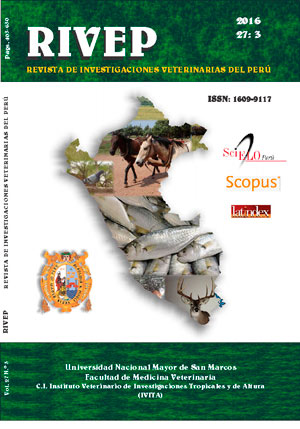Community ecology of metazoan parasites of pacific bonito Sarda chiliensis Cuvier, 1832 (Perciformes: Scombridae) from the Peruvian coast
DOI:
https://doi.org/10.15381/rivep.v27i3.12008Keywords:
Anisakis, parasite ecology, fish parasites, Peru, Sphyriocephalus, UnitubulotestisAbstract
Metazoan parasite community of S. chiliensis of Peruvian shoreline was analyzed. Specimens of S. chiliensis (n=100) were collected from Fishing Terminal of Chorrillos, Lima, Peru between January 2013 and December 2014. Necropsies were conducted to study their metazoan parasite community. Tapeworms dominated species richness and percentage of collected individuals (N=5; 44.6%), followed by nematodes (N=4; 27.0%), acanthocephalan (N=3; 2%), flukes (N=1; 23.2%) and finally the parasitic copepods (N=1, 3%). Endoparasites dominated (97%) against ectoparasites (3%). The 21.4% of collected parasites were mature forms of metazoan gill and gastrointestinal location and 78.6% were larval forms. The three parasites with more specific importance (average prevalence and abundance) of 14 taxa were Sphyriocephalus tergestinus, Anisakis sp2 and Unitubulotestis pelamydis. The total length of S. chiliensis did not presented association between prevalence and abundance of two parasites, except for U. pelamydis that showed a relationship between the prevalence and size of the fish. The comparison between the values of kn (relative condition factor) between parasitized and non-parasitized S. chiliensis showed differences for the three parasites, having higher values in non-parasitized. The values of alpha diversity showed higher values in females than in males of S. chiliensis. Values of Chao-2 show that in the community component is required to increase the sample size because was expected to find up to 18 species (22%).Downloads
Downloads
Published
Issue
Section
License
Copyright (c) 2016 Jhon Chero, Gloria Sáez, José Iannacone, Celso Cruces, Lorena Alvariño, José Luque

This work is licensed under a Creative Commons Attribution-NonCommercial-ShareAlike 4.0 International License.
AUTHORS RETAIN THEIR RIGHTS:
a. Authors retain their trade mark rights and patent, and also on any process or procedure described in the article.
b. Authors retain their right to share, copy, distribute, perform and publicly communicate their article (eg, to place their article in an institutional repository or publish it in a book), with an acknowledgment of its initial publication in the Revista de Investigaciones Veterinarias del Perú (RIVEP).
c. Authors retain theirs right to make a subsequent publication of their work, to use the article or any part thereof (eg a compilation of his papers, lecture notes, thesis, or a book), always indicating the source of publication (the originator of the work, journal, volume, number and date).



